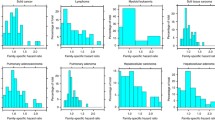VII. Conclusions
1. In confirmation of previous investigations, the breeding experiments of the present author have shown that cancer susceptibility in mice is hereditary.
2. No reason was found in favour of the idea of cancer being dominant, if it is a simple mendelian character.
3. Evidence is presented in favour of the hypothesis of multiplicity of controlling hereditary factors. This makes the problem of dominance extremely complex, but less urgent from the practical point of view.
4. Various histological types of tumours present considerable differences in their hereditary behaviour.
5. Since the males can be potentially cancerous but behaving as cancer-free, they must not be computed together with the females when mammary gland adenocarcinoma is concerned.
Similar content being viewed by others
References
Bashford, E. F. (1909). “Heredity in cancer.”Proc. Roy. Soc. Med. January.
Bashford, E. F. andMurray, J. A. (1909). “On the occurrence of cancer in mice of known age.”Royal Soc. Proc. 81, 310.
Cuénot, L. andMercier, L. (1910). “Étude sur le cancer des souris. L’hérédité de la sensibilité à la greffe cancéreuse.”C.R. Acad. Sc. Paris,150, 1443–6.
—— —— (1910). “L’hérédité de la sensibilité à la greffe cancéreuse chez les souris. Résultats confirmatifs.”C.R. Soc. Biol. Paris,69, 645–6.
Dobrovolskaïa-Zavadskaïa, N. (1929). “Sur l’hérédité de la prédisposition au cancer spontané chez la souris.”C.R. Soc. Biol. Paris,101, 518–20.
—— (1932). “Distribution de cas de lymphadénome dans une lignée de souris.”C.R. Soc. Biol. Paris,109, 263–5.
—— (1932). “Rapprochement de différentes lignées cancéreuses de souris au point de vue de la distribution des cas de lymphadénome.”C.R. Soc. Biol. Paris,109, 339–41.
-- (1933), “Heredity of cancer.”Amer. Journ. Cancer (in press). It contains a list of previous publications on this subject by the same author.
Dobrovolskaïa-Zavadskaïa, N. andKobozieff, N. (1931). “L’âge du cancer chez la souris.”C.R. Soc. Biol. Paris,107, 568–71.
—— —— (1932). “Terminaison sus-pelvienne de la colonne vertébrale chez les souris adultes sans queue.”C.R. Soc. Biol. Paris,109, 346–8.
—— —— (1932). “L’interruptıon de la colonne vertébrale au niveau du tronc chez les souris brachyures et anoures.”C.R. Soc. Biol. 109, 420–3.
Haaland, M. (1907). “Beobachtungen über natürliche Geschwülstresistenz bei Mäusen.”Berl. klin. Woch. 23, 713–18.
Lathrop, A. E. C. andLoeb, L. (1913). “The incidence of cancer in various strains of mice.”Proc. Soc. Exp. Biol. and Med. 11, 34–8.
Little, C. C. andStrong, L. C. (1924). “Genetic studies on the transplantation of two adenocarcinomata.”Journ. Exp. Zool. 41, 93–114.
Little, C. C. andTyzzer, E. E. (1916). “Further experimental studies on the inheritance of susceptibility to a transplantable tumour, carcinoma (J. w. A.) of the Japanese waltzing mouse.”Journ. Med. Res. 33, 393–453.
Loeb, L. andFleisher, M. S. (1913). “Untersuchungen über die Vererbung der das Tumorwachstum bestimmenden Faktoren.”Zbl. f. Bakt. u. Parasit. 67, 135–48.
Lynch, C. J. (1924). “Studies on the relation between tumour susceptibility and heredity.”Journ. Exp. Med. 39, 481–95.
MacDowell, E. C. andRichter, M. N. (1930). “Studies on mouse leukemia. II. Hereditary susceptibility to inoculated leukemia.”Journ. Can. Res. 14, 434–9.
Marsh, M. C. (1924). “Evidence of heredity among mammary tumour mice.”Journ. Canc. Res. 8, 518–19.
Mercier, L. andGosselin, L. (1931). “L’Hérédité d’un mode particulier de réceptivité à la greffe du cancer chez la souris albinos.”C.R. Soc. Biol. Paris,106, 1075–7.
Richter, M. N. andMacDowell, E. C. (1929). “The experimental transmission of leukemia in mice.”Proc. Soc. Exp. Biol. and Med. 26, 362–4.
Slye, M. (1914). “The incidence and inheritability of spontaneous cancer in mice.” Preliminary report.Ztsch. f. Krebsfor. 13, 500–4; Second report,Journ. Med. Res. 30, 281–98.
—— (1931). “The relation of heredity to cancer occurrence as shown in strain 621.”Amer. Journ. of Canc. 15, 2675–726 (contains a list of previous publications by the same author).
Tyzzer, E. E. (1907). “A study of heredity in relation to the development of tumours in mice.”Journ. Med. Res. 21, 479–518.
Author information
Authors and Affiliations
Additional information
Read before the Sixth International Congress of Genetics at Ithaca, N.Y., August 24–31, 1932.
Rights and permissions
About this article
Cite this article
Dobrovolskaïa-Zavadskaïa, N. Heredity of cancer susceptibility in mice. Journ. of Genetics 27, 181–198 (1933). https://doi.org/10.1007/BF02984411
Issue Date:
DOI: https://doi.org/10.1007/BF02984411




